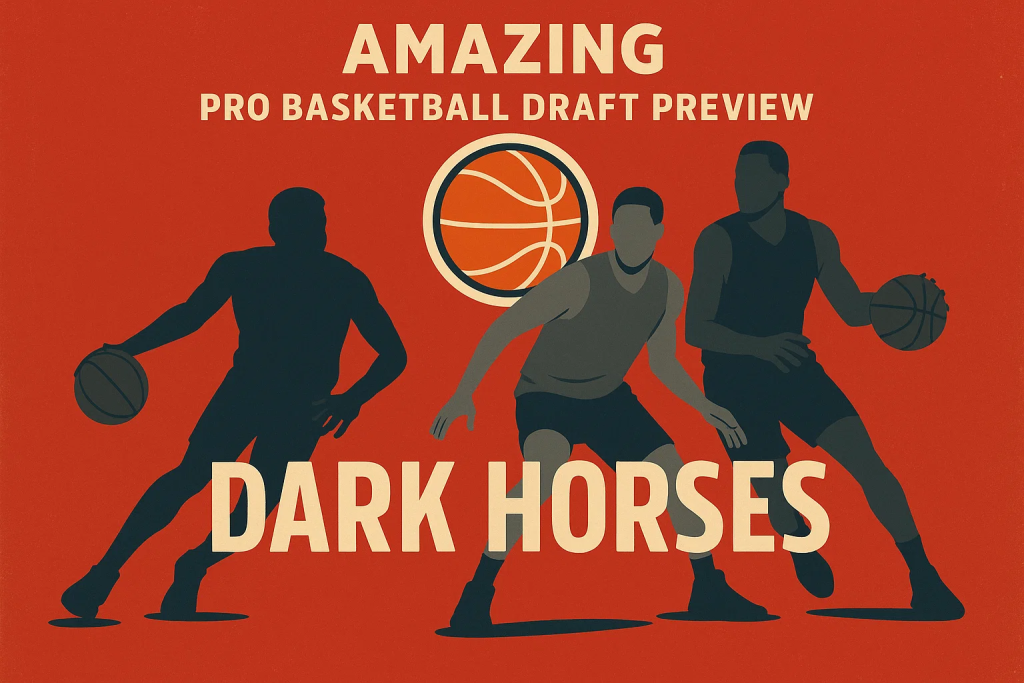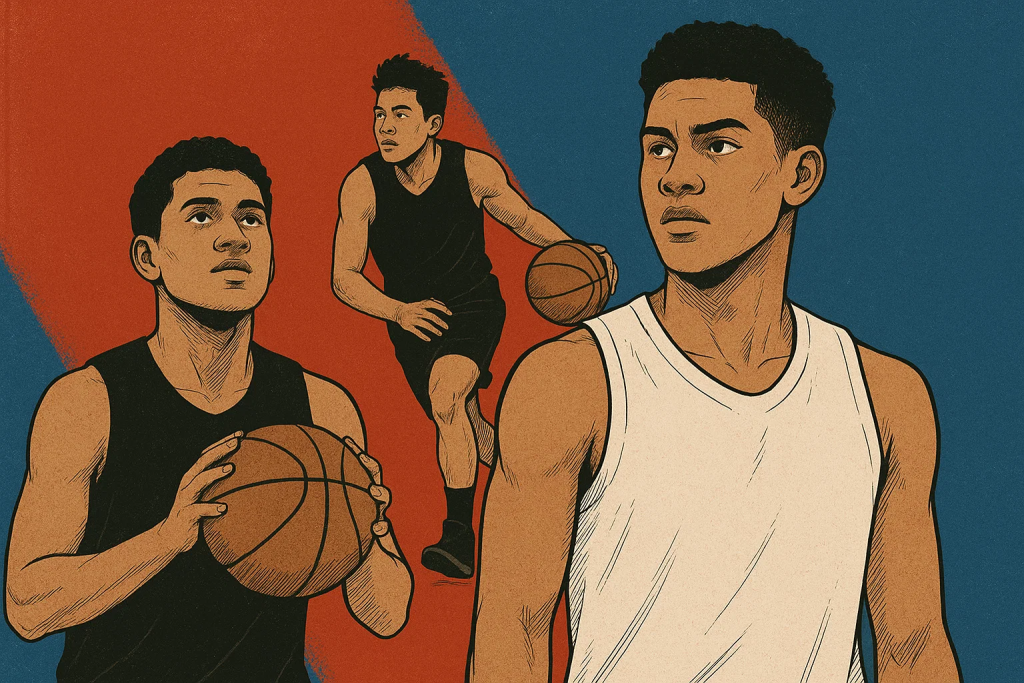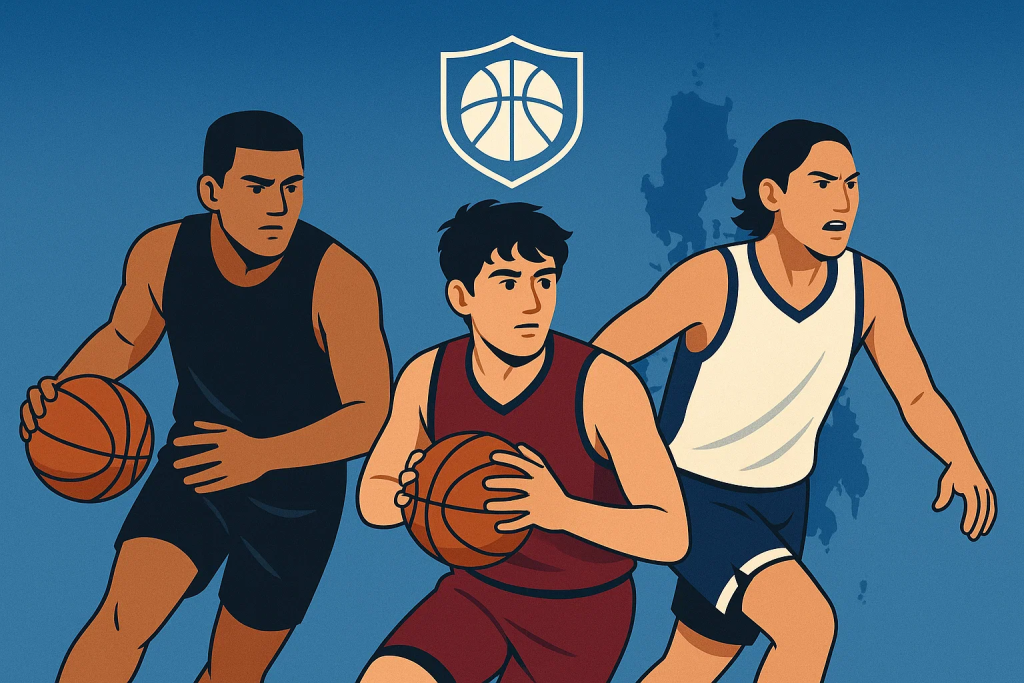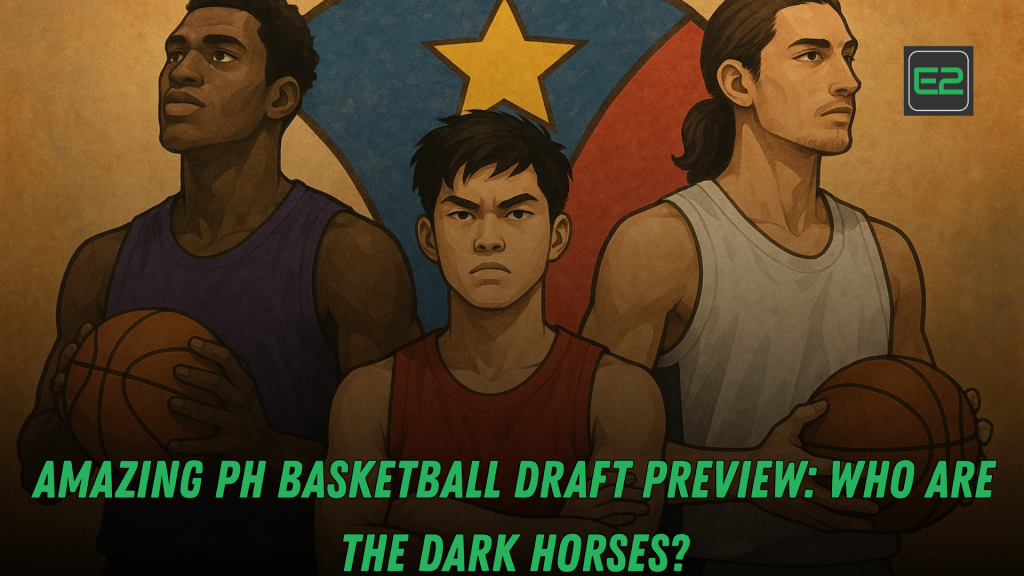Table of Contents
Editor’s note (updated September 23, 2025)
The PBA Season 50 Rookie Draft concluded on September 7, 2025 at the SM Mall of Asia Music Hall. Terrafirma selected Geo Chiu first overall, followed by Converge taking Juan Gomez de Liano and Blackwater picking Dalph Panopio, with Chris Koon going fourth to NorthPort and Ljay Gonzales fifth to NLEX. We reference the final order and first-round results where helpful, then keep the heart of this piece focused on “dark horses”—players outside the headline tier who project to outperform their draft position in the coming seasons.

Applications closed with 128 aspirants (later trimmed at the combine), reflecting a deep pool from UAAP, NCAA, MPBL and international circuits.
TL;DR — Which sleepers can punch above their weight?
- Jason Brickman (Meralco, 7th): Elite PnR organizer with plug-and-play value; age is a talking point, but assist equity travels anywhere.
- Christian Manaytay (Rain or Shine, 10th): Productive, sturdy combo forward archetype (defense + straight-line drives) who fits RoS’s “diamonds-in-the-rough” identity.
- Sonny Estil (Ginebra, 11th) & Arthur Roque (Rain or Shine, 12th): Two wings with “role clarity” (rebounding wing / 3-and-D) joining teams that historically maximize role players.
- Chris Miller (San Miguel, 9th): A lesser-known name on casual boards; lands in a structure that can simplify his reads and hide early-career weaknesses.
We’ll explain why these profiles work, how they fit, and what to watch in Year 1.
What do we mean by “dark horse” in the PH draft context?
A dark horse (or “sleeper”) is any prospect who—because of age, league visibility, limited usage, injury history, role ambiguity, or overseas obscurity—wasn’t widely projected as a star yet grades out as a strong value once context is accounted for (team fit, role scarcity, development track).
In the PBA ecosystem, sleepers often surface from three channels:
- Veteran guards with advanced pick-and-roll decision-making from MPBL/FIBA/SEA stints (high “assist equity” + low turnover profiles).
- Role-secure wings (team-defense, off-ball shooting, connective passing) who don’t need star usage to impact wins.
- Switch-capable bigs who run the floor, screen hard, and make the next pass—allowing coaches to keep modern coverages without over-tinkering lineups.
The draft backdrop: order, headlines, and what changed in 2025
A few macro notes set the table:
- Venue & date: SM MOA Music Hall, September 7, 2025.
- Top of board: Geo Chiu (Terrafirma), Juan GDL (Converge), Dalph Panopio (Blackwater), Chris Koon (NorthPort), Ljay Gonzales (NLEX) rounded out picks 1–5—names most fans expected near the top.
- Applicant volume: 128 initial applicants, later pruned for eligibility and combine; UAAP’s decision around student-athlete participation shaped the board.
- Media drumbeat: Outlets tracked the class as deep and balanced, with SPIN.ph flagging day-of favorites and post-draft winners/fit stories that matter for sleeper outcomes.
Why this matters for dark horses: when the top tier is stable, teams picking later in the first round (and into the second) can target specialist roles without FA-level bidding wars—great conditions for sleepers to stick.
Our dark-horse Draft lens: three grading levers that beat consensus
1) Role clarity > star upside
If a prospect can produce Day 1, 15 real minutes in a low-usage role—defend a spot, set screens, hit standstill threes, keep the ball moving—the floor is high. Philippine coaches tend to reward lineups that reduce decision complexity.
2) Portable skills
Skills that travel across teams score big: (a) PnR reads (manipulating tags/low man), (b) team-defense (nail stunts, X-outs), (c) shooting (catch-and-shoot 3s, corner gravity), (d) screening & DHO game, (e) defensive rebounding securing the possession.
3) Path independence
Players already exposed to pro habits (MPBL, KBL, SEA circuits, NBL-type environments) acclimate faster to travel, scouting, and no-excuses schedules—a predictor of Year-1 contribution.
5 dark-horse Draft cases (and why we’re in)
1) Jason Brickman — PG, 7th overall, Meralco Bolts
Why he was underrated by casuals: Age narrative and “we’ve seen him” bias often blunt excitement. But assists are a team stat you can individually force, and Brickman has done it in multiple leagues for a decade.
Translatable value:
- PnR command: manipulates weak-side tags, pitches on time to short-rolls, rarely over-dribbles.
- Pace control: Meralco under coach Luigi Trillo values half-court precision—Brickman’s wheelhouse.
- Locker room & habits: A “raise-the-floor” pro—exactly the kind who stabilizes bench units and late-game execution.
What to track: Team ORtg with Brickman on the floor, turnover percentage on second units, and assist points created per 36—if these spike, you’re watching a playoff-series swing piece. (And yes, 7th overall is still low for this archetype historically.)
2) Christian Manaytay — PF, 10th overall Draft, Rain or Shine
Why he fits RoS: The franchise has long specialized in finding value beyond the top five and carving out roles for multi-tool forwards. Manaytay gives them functional strength, board work, and simple offense (cuts, short rolls, put-backs).
Translatable value:
- 2-way tools: enough lateral agility to toggle between 3/4 matchups in local play; dependable defensive rebounding.
- Easy points: thrives on cleanups and dunker-spot timing when guards bend the defense.
- Identity match: Yeng Guiao’s teams (and RoS DNA generally) love play-hard, defend-hard forwards with motor and malleability.
What to track: On/off defensive rebounding rate; lineups where Manaytay is the only “true” big—do they survive? If yes, sleeper status validated.
3) Sonny Estil — SF/PF, 11th overall, Ginebra
Why this can pop fast: Ginebra squeezes real minutes from role-secure wings—run the lane, crash the glass, defend your spot, don’t break spacing. Estil’s energy game fits the Cone/Tim-system emphasis on flow and structure.
Translatable value:
- Rebounding wing: helps Ginebra stay big on the perimeter, a staple of their playoff success.
- Low-usage fit: Estil doesn’t need touches to be effective; he’s there to finish plays, not start them.
- Fan/brand runway: With Ginebra’s platform, role players often scale quicker (confidence, chemistry reps, late-game reps).
What to track: Team rebounding with Estil at the 3/4, corner-3 attempts created by his baseline cuts, and his foul rate (must stay defend-without-fouling).
4) Arthur Roque — SF/SG, 12th overall, Rain or Shine
Why we like it: Roque profiles as the connective wing—guard a couple of spots, knock down open 3s, swing-swing the ball one beat early. In modern PBA, one reliable 3-and-D wing can unlock whole five-man combos.
Translatable value:
- Positional defense: not a “point-of-attack eraser,” but rotates cleanly and closes airspace.
- Catch-and-shoot: if the corner 3 holds, he upgrades any group’s spacing.
- Stackable with Manaytay: RoS can field two value wings and switch lineups without sacrificing IQ.
What to track: Corner 3 volume; crash-down rotations on middle drives (X-out timing); net rating in second-unit wing-heavy lineups.
5) Chris Miller — SG, 9th overall, San Miguel Beermen
Why it’s sneaky: SMB’s structure and star gravity simplify life for supporting guards. A lesser-known profile entering draft week becomes dangerous when plugged beside spacing, screening, and post gravity.
Translatable value:
- Lineup shelter: Plays off stars; can specialize early (spot-up, second-side attacks).
- Defensive slotting: If he holds up on 1/2s and competes on the glass, he stays playable in SMB’s best units.
- Internal development: SMB has a track record of role definition, preventing scope creep for rookies.
What to track: Spot-up PPP (points per possession), catch-and-shoot 3PT%, and turnover rate when run off the line.

“But what about the headliners?” (Context matters for sleepers)
Top picks Geo Chiu, Juan GDL, Dalph Panopio, Chris Koon, Ljay Gonzales, Yukien Andrada, Will Gozum went in the first eight—a tier the media largely anticipated. For a preview aimed at dark horses, the top names matter because they set the board for everyone else: teams satisfied their “primary need” early, so later they shopped for role specialists—exactly where sleepers thrive.
Team-by-team sleeper fits (what we expect to age well)
- Meralco: With Brickman in the fold, the Bolts can run cleaner second-unit offense and protect late-game possessions. Expect finishing groups to toggle between two-guard control and strong-side DHO concepts.
- Rain or Shine: Manaytay + Roque is a classic RoS haul—work rate, defense, shooting. If one becomes a 20-minute fixture by All-Filipino midpoint, RoS will again look prescient.
- Ginebra: Estil can scale as a rebounding wing in a structure that prizes decision-light roles. If his baseline timing and corner 3 stick, he gets playoff minutes.
- San Miguel: Miller benefits from gravity lineups; if he simply takes and makes open 3s and defends to a draw, SMB gains a rotation piece on a discount.
The meta that makes dark horses draft matter in 2025
1) Pace-control guards are back in vogue.
With half-court defenses more organized, teams are valuing turnover-averse table-setters (hello, Brickman archetype) who run PnR at two tempos, not just downhill.
2) 3-and-D wings with actual team-defense IQ.
Not every wing who shoots 35% is playable in a series. The separator is rotation integrity—knowing when to tag the roller, when to peel switch, and how to X-out on strong-side overloads.
3) Switch-capable fours who rebound.
A 6’4”–6’6” forward who defensive rebounds, sets real angle screens, and won’t die on switches has huge lineup unlock value, especially for coaches who mix drop, switch, and show/rec.
How we graded sleepers (your DIY checklist)
- Portability score (0–10): shooting, screening, decision speed, defensive versatility.
- Role clarity (0–10): how quickly a coach can say, “Here’s your 12-minute job.”
- Team fit (0–10): scheme symmetry with existing stars and bench patterns.
- Risk factors: age, injury history, foul rate, handle under pressure, motor consistency.
- Time-to-trust: how many games before they can be in a close-game five.
If you’re building a personal draft board, this framework outperforms name recognition.
What the numbers and reporting tell us (and where to be careful)
- Applicant depth: 128 entries (122 at the final combine list) led to real competition for fringe rotation roles.
- Draft-day storylines: SPIN.ph and ABS-CBN tracked early favorites and post-draft fit pieces—useful for calibrating expectations beyond hype.
- Historical caution: Mock drafts and Reddit boards can spotlight names (CJ Lane, etc.) but aren’t vetted against eligibility or final lists—use as sentiment, not gospel.
What success looks like for these dark horses (Year-1, Year-2 markers)
Year-1 goals
- Earn 10–15 stable minutes without a nightly DNP-CD.
- Positive on/off in second-unit lineups.
- Clear usage identity (PnR organizer, 3-and-D, rebounding wing).
Year-2 goals
- Graduate into closer in specific game scripts (protect a lead, need a stop, need a corner 3).
- Trust from staff in scouting-dependent rotations during playoffs.
- Positive net rating with at least one star on floor.
Risks that can stall a sleeper (and how teams mitigate them)
- Foul trouble for forwards defending up a position → mitigation: technique work (verticality, chest-first contests).
- Shooting variance on small samples → mitigation: diet of shots (more corners, more catch-and-shoot, fewer off-dribble long 2s).
- Turnover spikes when asked to create → mitigation: relocate them to advantage touches (second-side, short roll, DHO chase).
- Role creep on injury-hit rosters → mitigation: codify hard minutes caps during early months, protect identities.
How fans should watch the first 20 games
- Track who shares the floor with your sleeper—bench combos matter.
- Don’t overreact to one cold week; look at shot quality (open vs contested).
- Watch defensive possessions, not just steals/blocks; winning two rotations in a row often keeps you in the game plan.
SEO corner: content angles you can spin from this preview
- H2 explainer: “Why PnR table-setters are undervalued in the PBA.”
- Film thread: “Two possessions that show why Arthur Roque fits RoS.”
- Data note: “Brickman’s assist points created vs. league average bench units.”
- Team blog: “How Ginebra’s rebounding wings shape late-game lineups.”
Link those articles back to this pillar page for topical authority.
Call to Action (players, coaches, and fans)
Players & agents: Send your role reel (2–3 minutes) + a simple data card (age, height, primary role, shooting splits, assist/TO). I’ll reply with a role-fit audit and a 6-week development plan to raise your portability score.
Coaches: Share one full game + one 10-minute segment (bench unit). I’ll map two rotation shells that maximize your dark-horse prospect without sacrificing spacing or coverage rules.
Fans & creators: Drop the sleeper you’re most bullish on (and why). I’ll pick three comments and cut a mini breakdown you can post with SEO-ready captions.
Baseball Revival: PH Amazing Batters Take Aim at Asian League
Final word
Every draft crowns headliners; winning seasons are built by the dark horses who make second units hum, close weird game scripts, and never break coverage rules. In 2025, the archetypes are clear: a veteran PnR steward, a rebounding wing who plays within himself, and a 3-and-D connector who sees help-side pictures a beat early. If even two of the sleepers above hit their Year-1 markers, we’ll be talking about them—not as steals—but as system wins that prove how the PH draft rewards portable skills and role clarity.

If you’ve got a sleeper in mind we didn’t cover, tell me the role, team, and lineup you’d play him with—and let’s build the rotation that makes him pop.
Sources & quick facts you can verify
- Draft venue, date, No. 1 pick & first-round rundown — PBA Season 50 official pages & Wikipedia entry; SPIN.ph’s draft-day coverage.
- Applicant count (128) and “full list” news updates — ABS-CBN Sports; PBA release posts.
- Pre-draft order chatter & combine notes — SPIN.ph pre-deadline and post-combine articles.
FAQs — PH Basketball Draft Dark Horses
1) What makes a true “dark horse” in the PBA Draft?
A prospect whose role value (defense, shooting, PnR pacing, rebounding) is higher than public consensus, often due to age, low visibility, or non-headline leagues. The key is portability—skills that plug into any coach’s rotation.
2) Why are veteran guards (like Jason Brickman) still great values?
3) Which archetypes typically overperform draft slot in the Philippines?
PnR organizers (low-mistake table-setters)
3-and-D wings with real team-defense IQ
Switchable fours who rebound and screen
4) How do I evaluate a sleeper without advanced stats?
Watch for shot selection discipline, defensive positioning, first-touch decisions (hold vs swing vs drive), and foul economy. You’ll “feel” whether the lineup becomes easier to run when they’re on.
